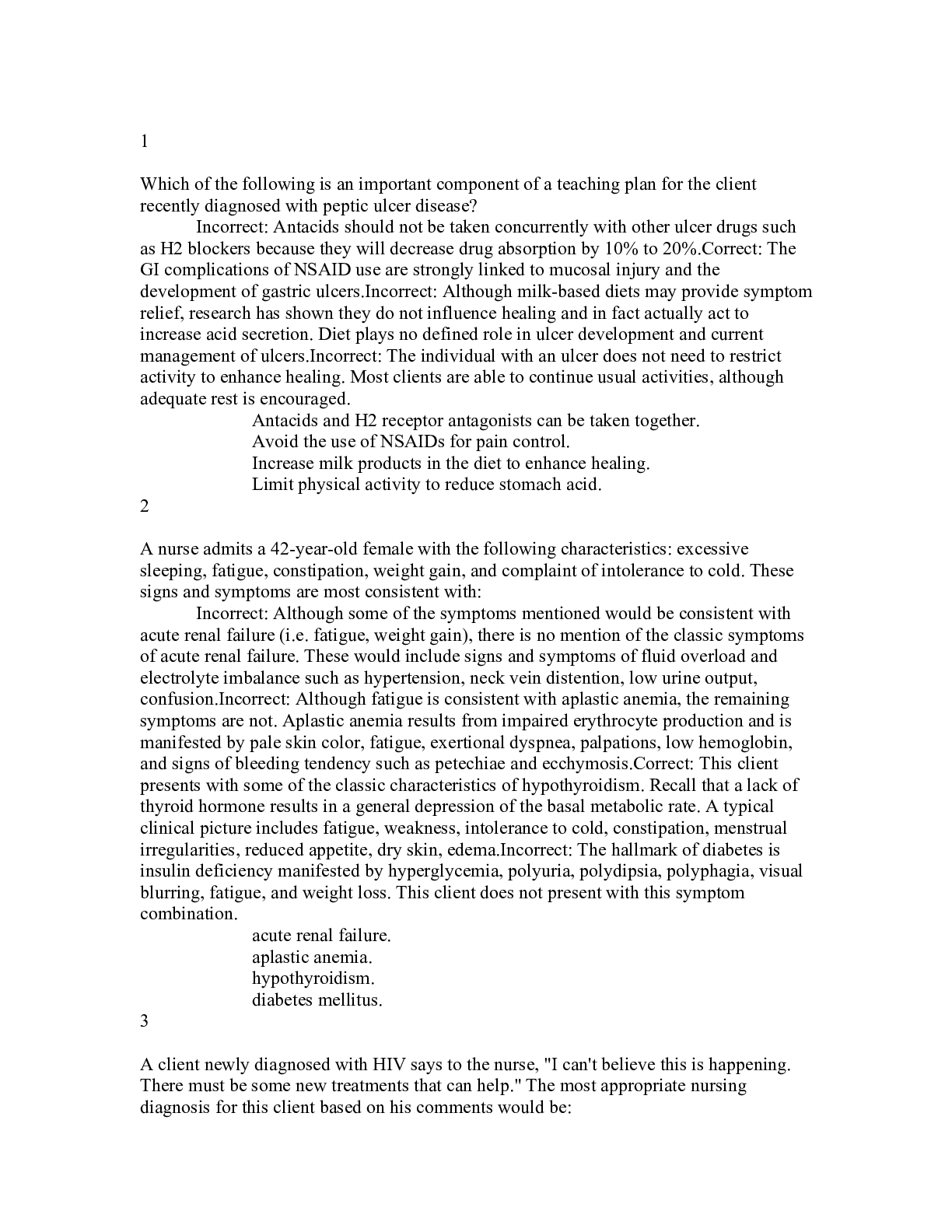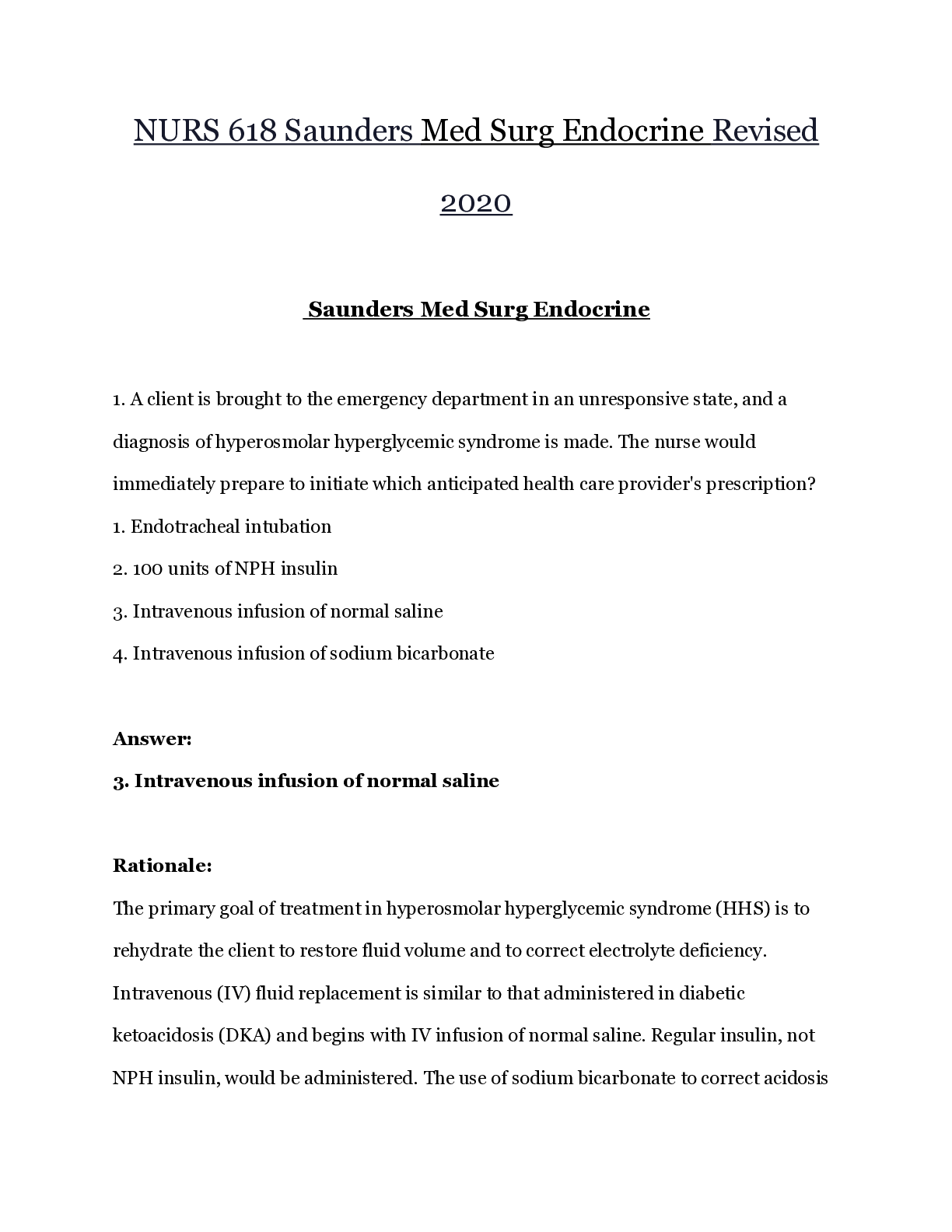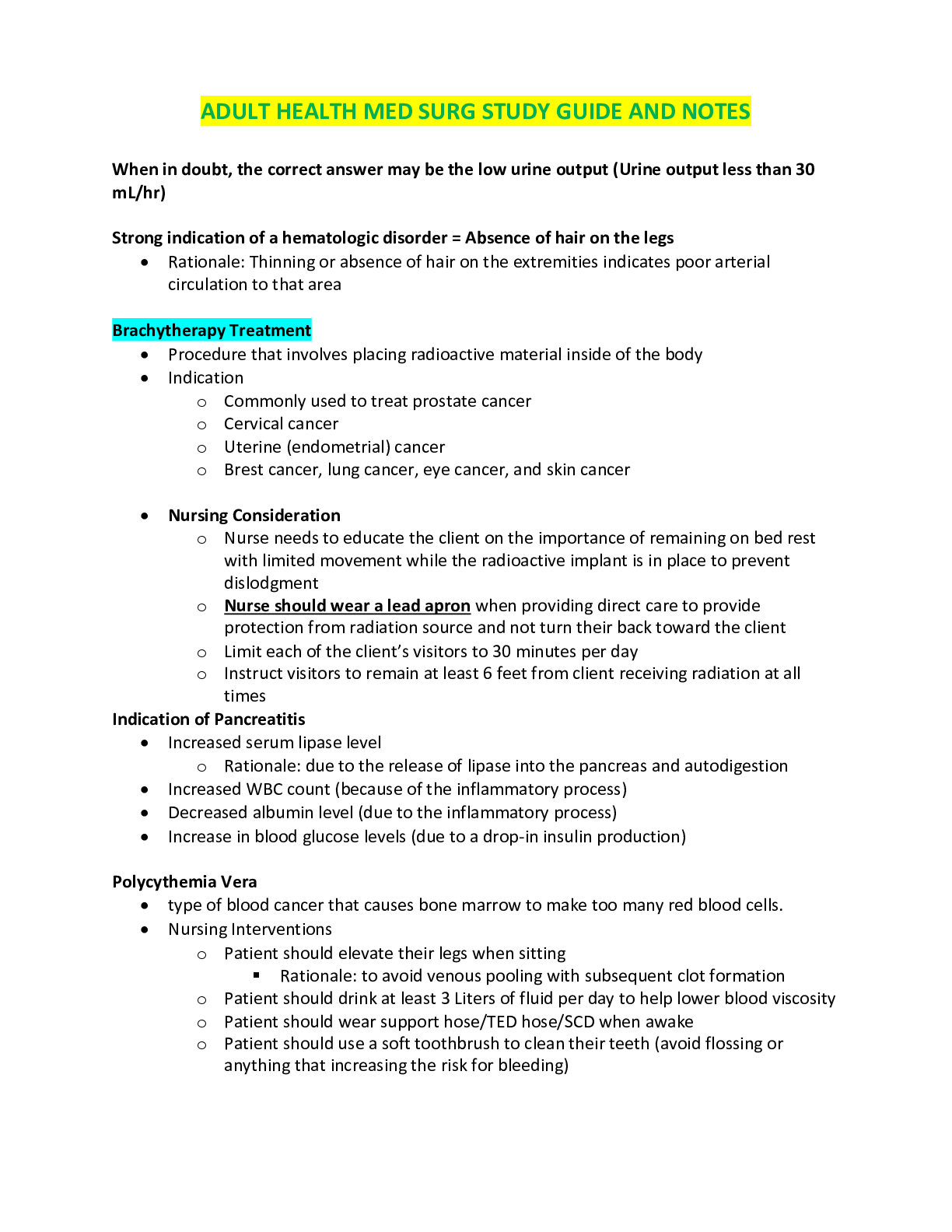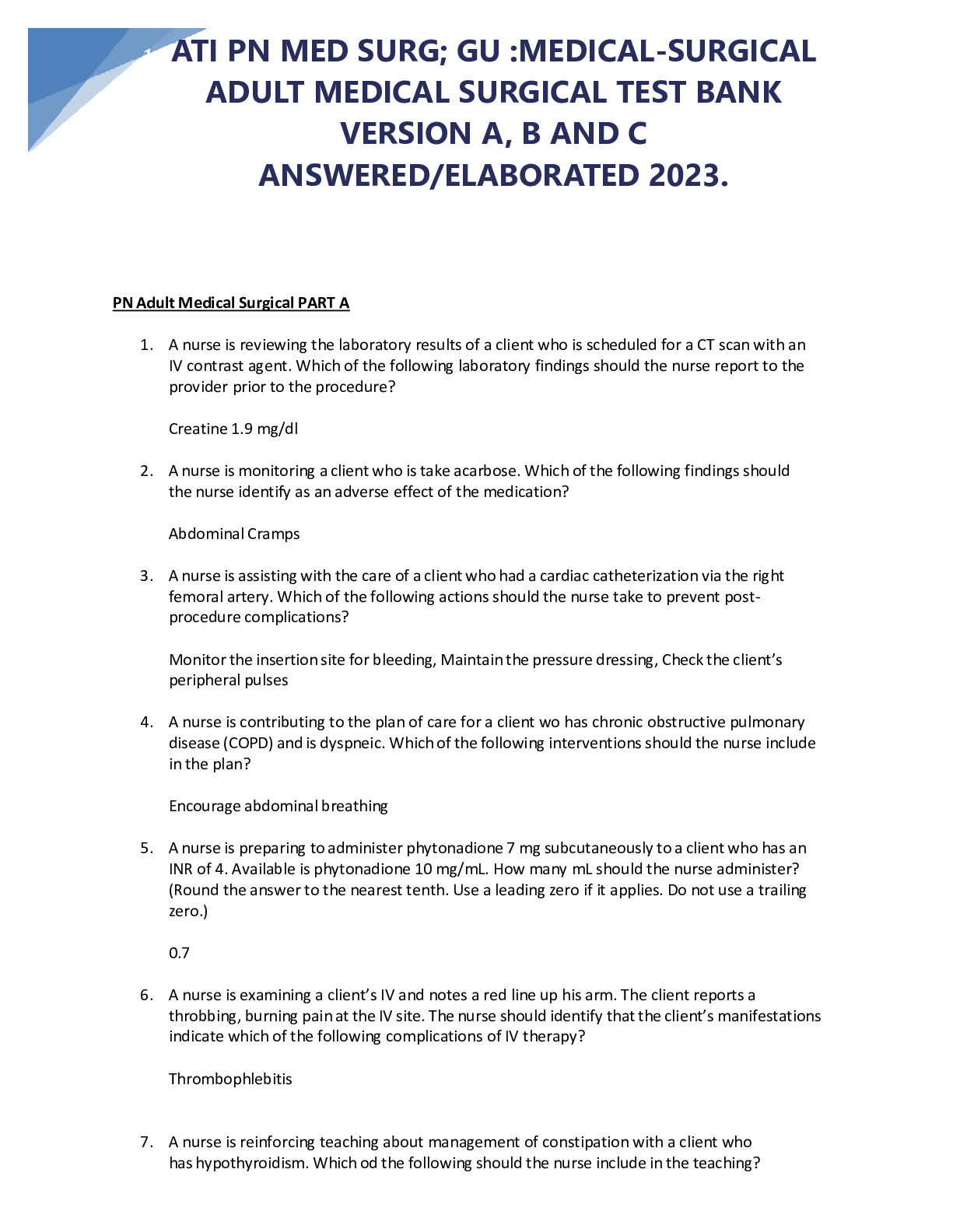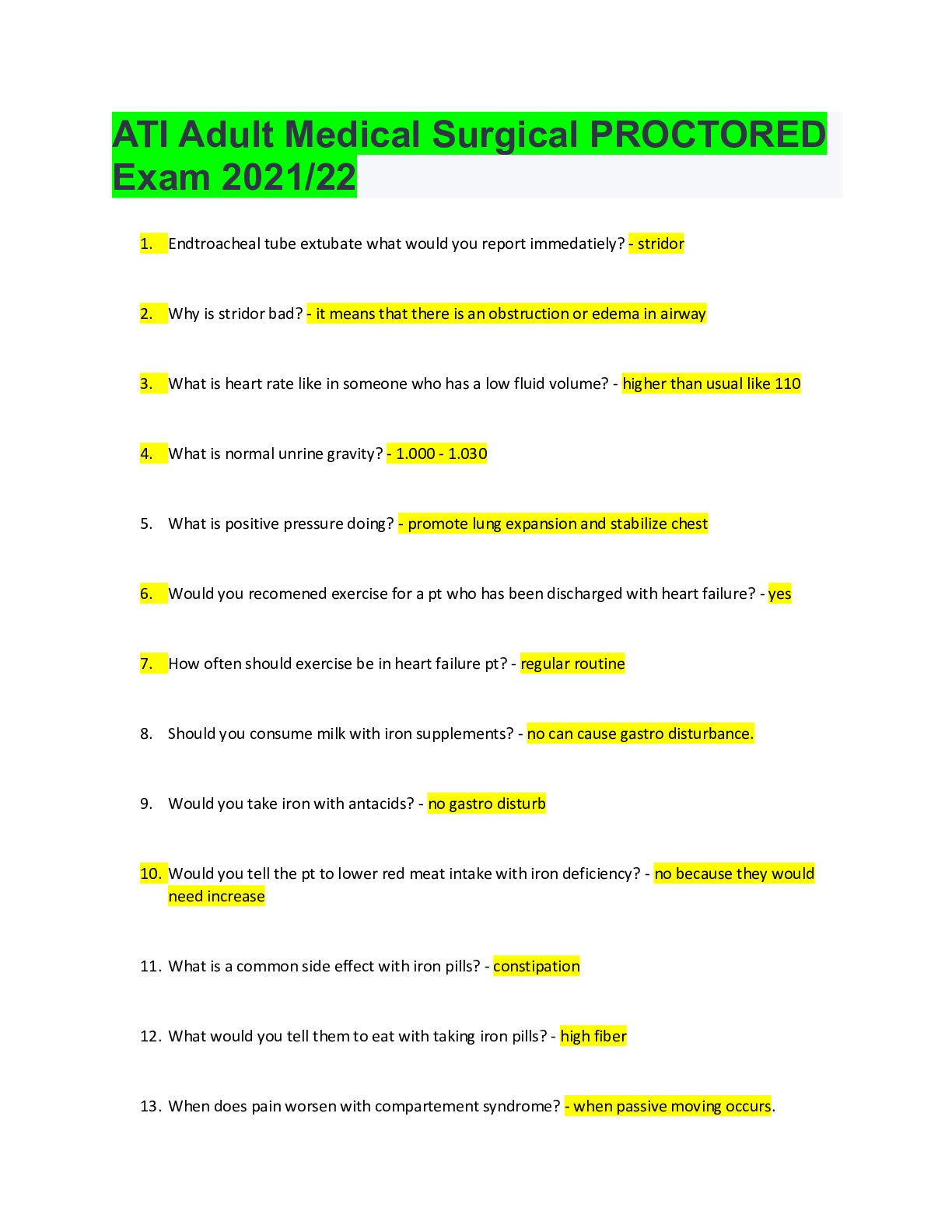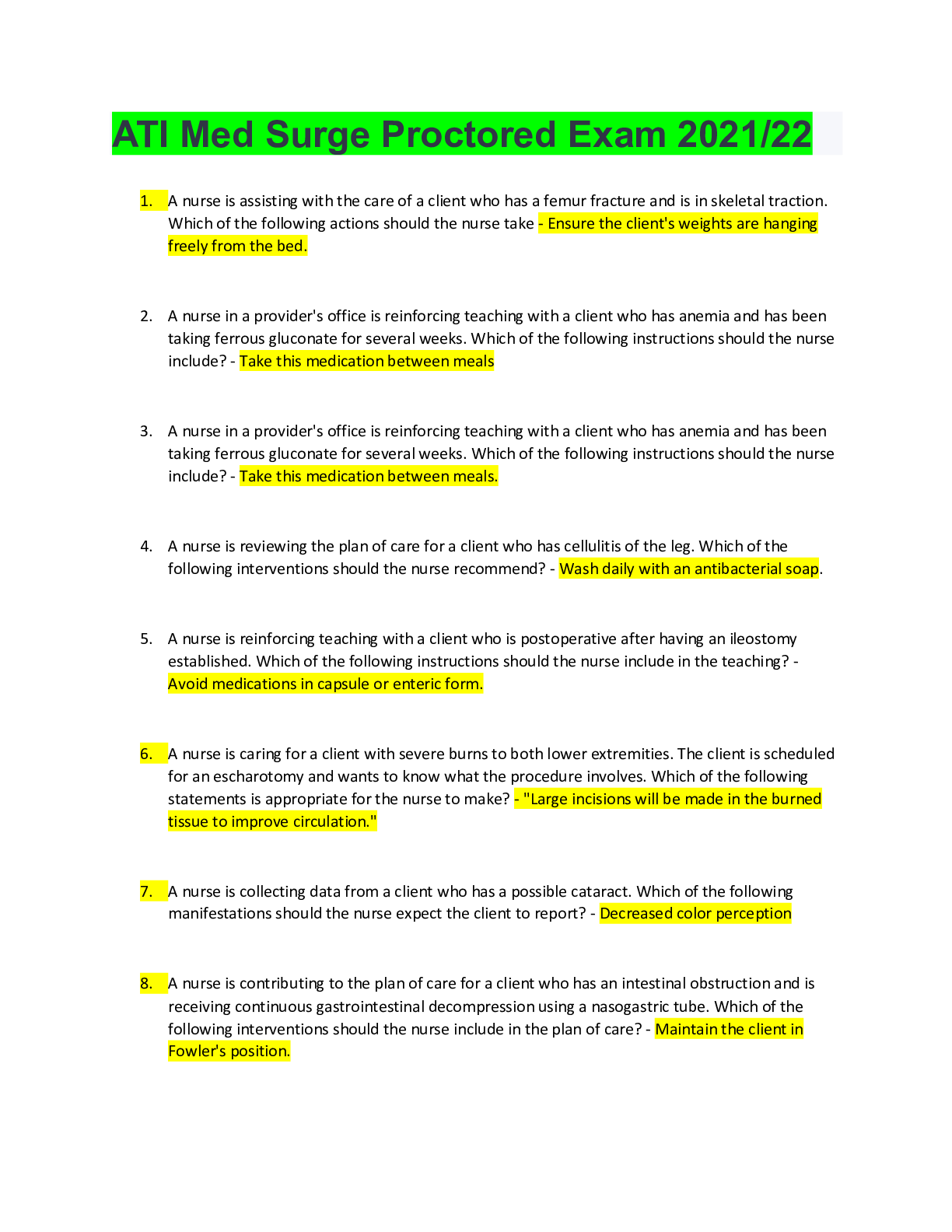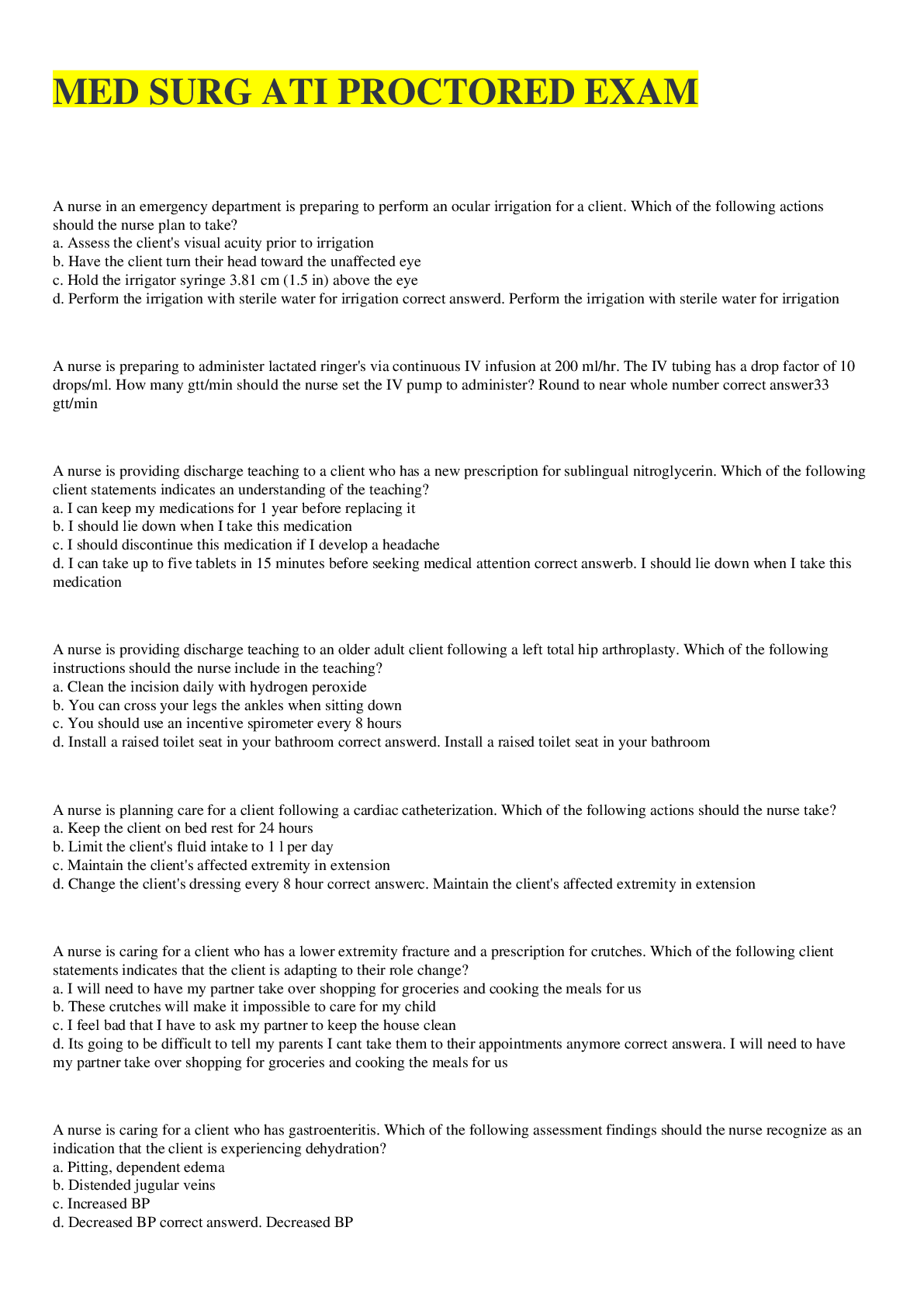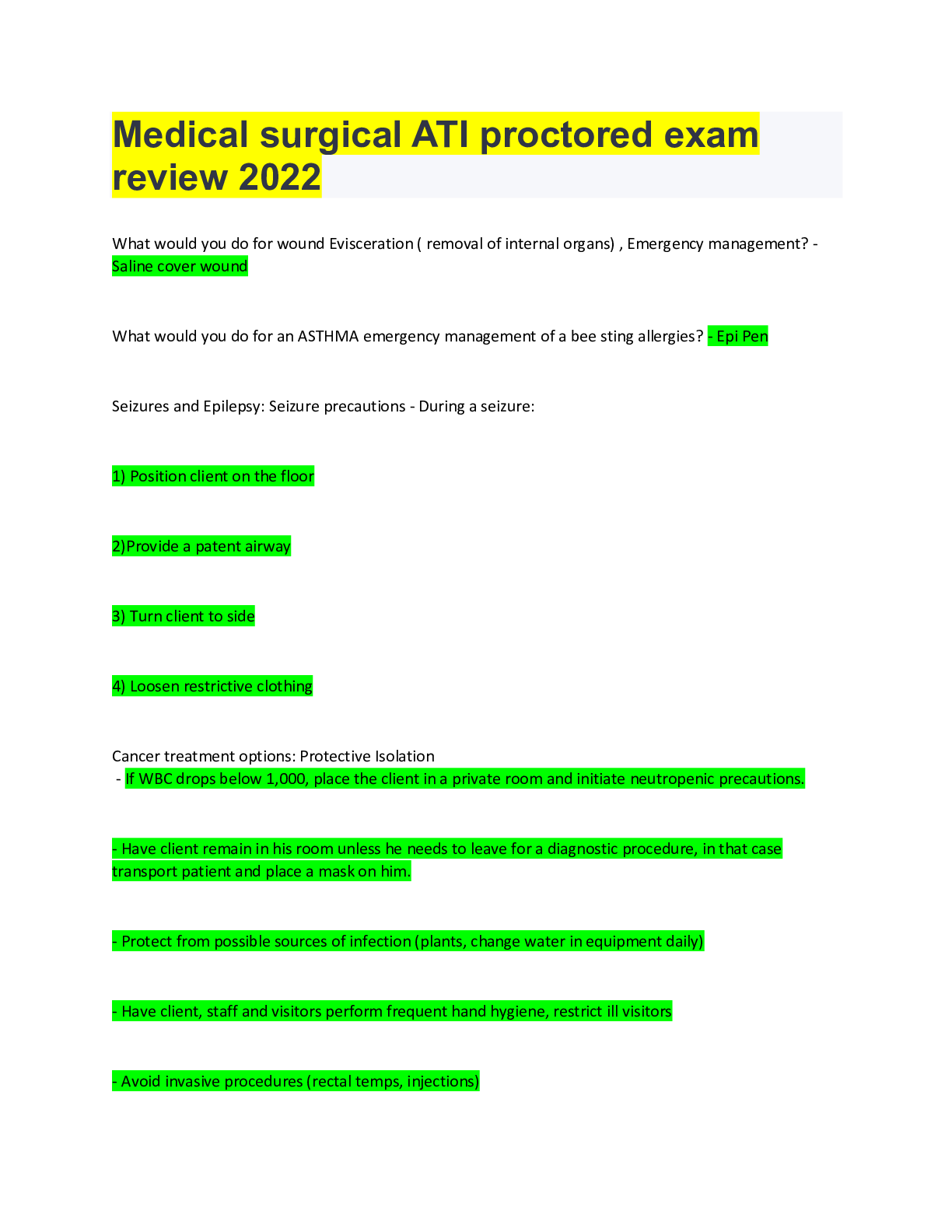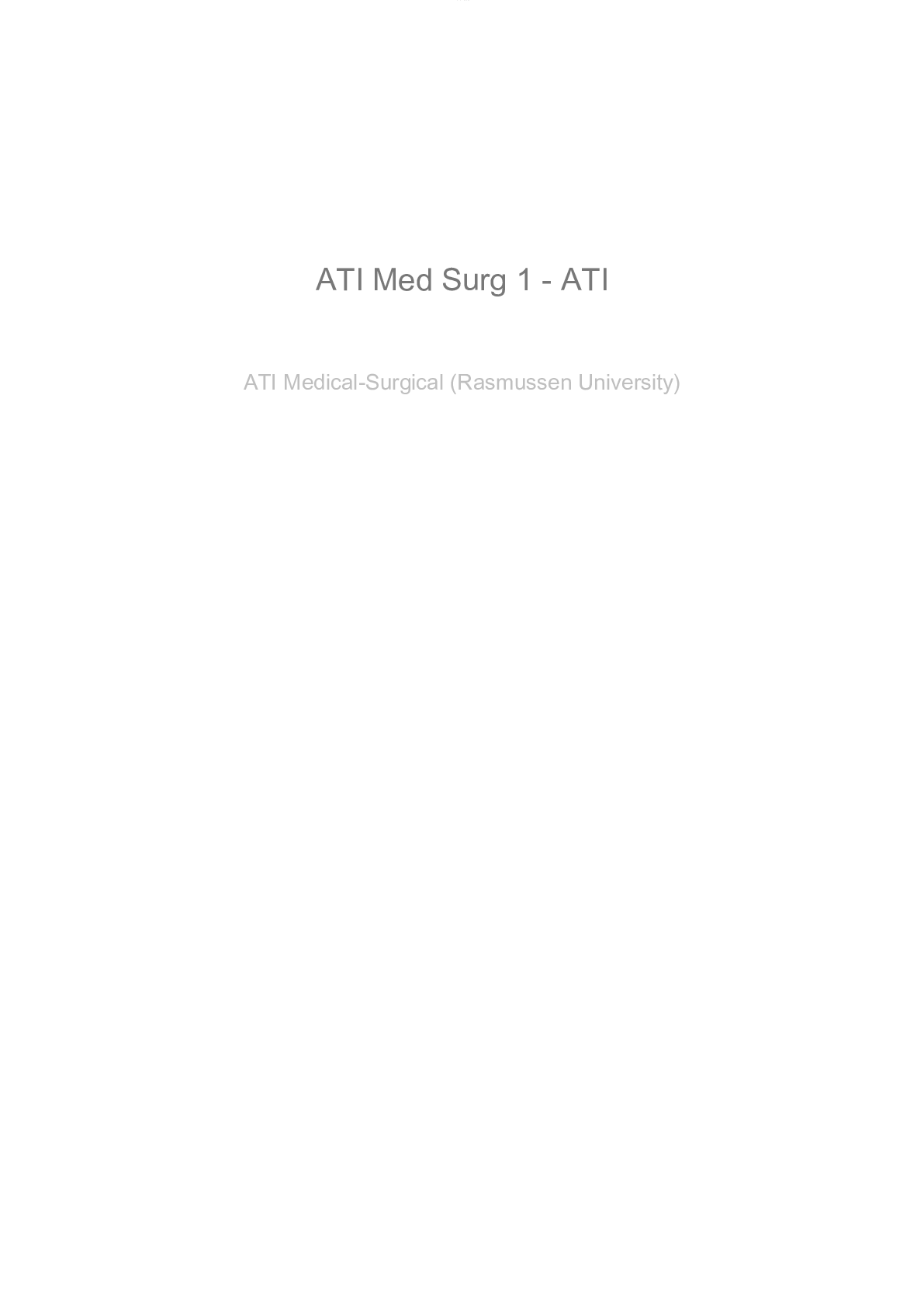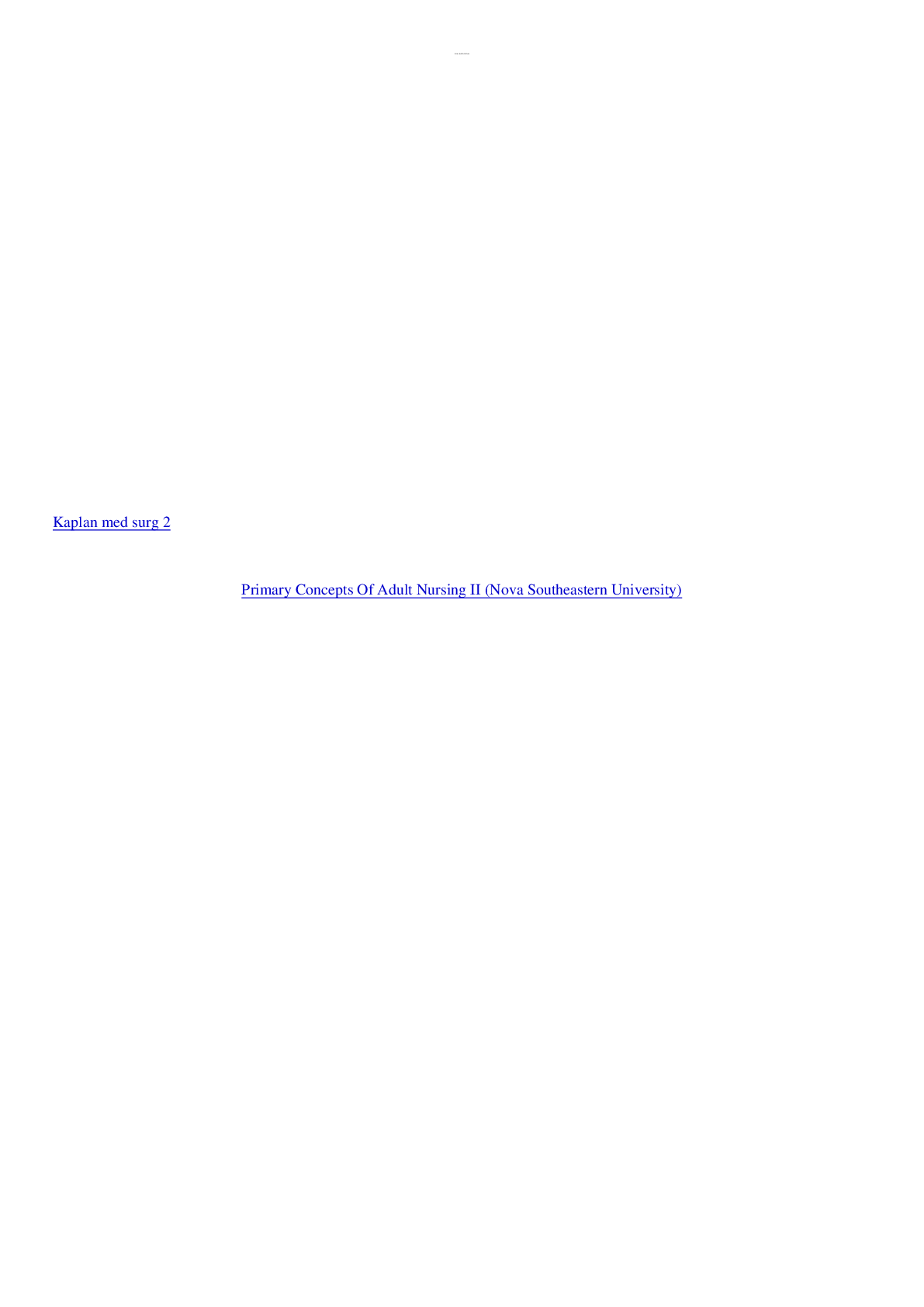Surgery > MED-SURG EXAM > MED SURGE 1 FINAL QUESTIONS AND ANSWERS (All)
MED SURGE 1 FINAL QUESTIONS AND ANSWERS
Document Content and Description Below
1) Acute exacerbation of COPD the patient will show – – Increased dyspnea 2) The most accurate measurement of O2 concentration in the blood – – ABG study 3) Post bronchoscopy, when can y... ou give fluids – – When the cough and gag reflex returns 4) Air inspired and expired with normal breath – – Tidal volume 5) Pleural effusion respiratory assessment findings – – Lung fields dull on percussion, absent breath sounds, pleural friction rub 6) Condition that increases long compliance – – Emphysema 7) When is the best time to perform a sputum study – – First thing in the morning 8) Thoracotomy pre op teaching – – How to split the incision while coughing 9) Water seal chest drainage system used for – – Removing excess air and fluid 10) Postural drainage – – Assist the patient into a position that will allow gravity to move the secretions 11)Tricks patient on mechanical ventilation; cuff care – – Monitor pressure on the cough at least every eight hours 12)Benefit of CPAP – – Allows a lower level of oxygen with similar effect 13)Removal from vent the order of the steps is – – Removal from ventilator, tube, then oxygen 14) COPD exacerbation needs precise O2 delivery – – Use Venturi mask 15)Best indicator the patient can be successfully weaned off the ventilator – – Stable vital signs and ABGs 16)To minimize the risk of COPD the most important risk factor is – – Smoking 17)How to distinguish between normal breath sounds– – Based on their location over a specific area of the lung 18) Post op pleural effusion the patient underwent thoracoscopic procedure priority assessment – – SOB CLAUSE STUVIA 19) Exacerbation of COPD symptoms. What breath sounds will you hear – – Faint breath sounds with prolonged expirations OR wheezing with discontinuous breath sounds 20) Pneumothorax post tracheostomy chest tube inserted the purpose of the chest tube is – – Remove air from pleural space 21) Patient has unexplained weight loss and a history of smoking. What sign indicates early stages of laryngeal cancer – – Hoarseness 22)Daytime sleepiness, difficulty going to sleep at night, and snoring – – Obstructive sleep apnea 23) Post update to total laryngectomy for supraglottic cancer primary assessment– – Swallowing ability 24)To decrease risk of pulmonary embolism – – Early ambulation 25)Accident, patient comes in with signs and symptoms of headache, fatigue, and feeling like she just can't breathe enough. She is restless and tachycardic with an increased blood pressure – – Early signs of acute respiratory failure 26) Early stages of lung cancer; preferred method of treatment for patients with non-small cell tumors – – Surgical resection 27) Emphysema patient has shortness of breath – – Set them up right, lean forward slightly 28) Cystic fibrosis – – You will have an elevated sweat chloride concentration 29)Amazacort, inhaled corticosteroid medication, adverse effect – – Cough and oral thrush 30) Chest tube drainage system – – -Gentle constant bubbling in the suction control chamber, rise and fall in the level of fluid in the water Seal chamber with inspiration and expiration 31)TB patient on ethambutol – – Tell patients to watch for changes in vision 32)Increase rate and depth with periods of apnea – – Cheyne-Stokes 33)The positioning for thoracentesis – – Sitting on the edge of the bed while leaning over a pillow placed on the bedside table 34) Flolan (Epoprostenol)– – History of pulmonary artery hypertension 35) COPD exacerbation- – Methylprednisolone (Solu-Medrol) ordered 36)Auscultation breath sounds of a patient with a history of a left pneumothorax – notes no breath sounds over the left chest. What do you do – – Document this is normal 37) Caring for a client into pitted for two days, the cuff pressure is 31 cm of H2O what should the nurse do first – – Deflate air from the cough so that the pressure is within normal limits 38) Pavulon- an important nursing consideration is – – Meticulous eye care 39) Lobectomy – – Removal of a single lung lobe 40)Nursing implementation: – Ambulate patient 2x a day with partial assistance 41)Bronchoscopy: – Consent, fasting, topical anesthetic, swallowing reflexes 42) Community acquired pneumonia: – Ineffective airway clearance related to tracheobronchial secretions 43) Planning phase for streptococcus pneumoniae: – Achieve SAO2 less than or equal to 92% at all times 44)Unstoppable nosebleed: – Protamine sulfate 45) Epipen: – Patient will demonstrate correct injection technique with todays teaching 46) Endotracheal suction: – Only apply suction when withdraw, medical aseptic technique, sterile catheter, hyperoxygenation 47) Spontaneous pneumothorax: – Tracheal deviation to the affected side 48) Spontaneous pneumothorax – Absent breath sounds on affected side 49)What must precede the determination of this nursing diagnosis: – Educating and analyzing data that corroborates the diagnosis 50) CT scan: – Increase fluid contrast because of contrast 51) MOLST: – End of life care [Show More]
Last updated: 1 year ago
Preview 1 out of 18 pages

Reviews( 0 )
Document information
Connected school, study & course
About the document
Uploaded On
Feb 14, 2023
Number of pages
18
Written in
Additional information
This document has been written for:
Uploaded
Feb 14, 2023
Downloads
0
Views
30

